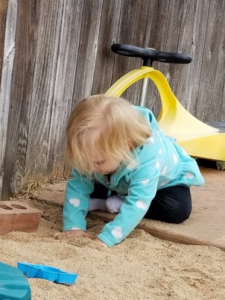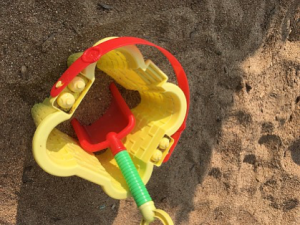Mathematical Magic of Sandcastles
Process art is important to young learners. It speaks to the idea that children do not need structured, planned out, learning opportunities but instead appreciate the opportunity for rich experiences through exploration and wonder. Finding ways to encourage children’s interests in the early learning environment builds important brain connections. Children feel supported as they understand their role in constructing their knowledge and development. They develop confidence as they ask questions and estimate results.  Playful opportunities for children to enjoy sand activities through self-directed choices can support the understanding of math in a language that children understand. Children have a natural curiosity about sand as they dig, sift, measure, build, and sculpt. They enjoy the feeling of it through their fingers and between their toes. Children ask to play in the sand often. It’s one of the favorite materials for the explorative nature of young investigators. Sand has many uses and there are no right or wrong ways to create with it. Mathematical concepts can be developed during sand play by providing rocks to count and sort, spoons and cups to measure, and supporting language with mathematical terms like heavy and light or empty and full. Adding art materials to sand play such as feathers, beads, glitter, and paint adds another layer of discovery and creativity. Add water to the sand box and you suddenly have a whole new adventure. Combining a variety of materials to sand play enhances the imagination and offers more opportunities to bring math into the box. Sand invites multiple children to participate while testing theories, learning new concepts, and strengthening social skills. While building and sculpting supports the imagination, adding and subtracting seashells or block play supports math concepts.
Playful opportunities for children to enjoy sand activities through self-directed choices can support the understanding of math in a language that children understand. Children have a natural curiosity about sand as they dig, sift, measure, build, and sculpt. They enjoy the feeling of it through their fingers and between their toes. Children ask to play in the sand often. It’s one of the favorite materials for the explorative nature of young investigators. Sand has many uses and there are no right or wrong ways to create with it. Mathematical concepts can be developed during sand play by providing rocks to count and sort, spoons and cups to measure, and supporting language with mathematical terms like heavy and light or empty and full. Adding art materials to sand play such as feathers, beads, glitter, and paint adds another layer of discovery and creativity. Add water to the sand box and you suddenly have a whole new adventure. Combining a variety of materials to sand play enhances the imagination and offers more opportunities to bring math into the box. Sand invites multiple children to participate while testing theories, learning new concepts, and strengthening social skills. While building and sculpting supports the imagination, adding and subtracting seashells or block play supports math concepts.
For children to feel connected to their own learning experiences, artistic activities should be open-ended with a variety of questioning opportunities. Observation and guidance in nondirective ways help children feel supported yet independent. Asking questions such as, “what else could you add?” and “what could we do if we take these away?” allow for children to problem solve and support one another. Vygotsky (1933) called this observation and questioning technique the scaffolding process. This supportive process enables children to take their knowledge deeper. By encouraging children with open-ended questions, they will play an important role in designing their own experiences. This process allows for purposeful, independent play which increases knowledge along with encouraging the joy of learning.
When I am looking for connections that can be found between math, art, and sand, I think about how children tend to resolve problems. Children will try challenges that are puzzling enough to be fascinating yet not completely beyond their abilities to resolve. I invite children to think about the natural relationships between math and art while they are engaged in activities. The range of children’s questions are impressive when they are involved in this style of play. I hear them ask questions such as “how tall should we make the castle?” Children will often consult other children about design ideas and materials to use. They will ask each other to help find pretty rocks or decide how many items to add. It’s the beauty of math in collaboration, investigation, and social skills all naturally occurring from the basis of play.
Love the sand activity. Children can explore all kinds of ways dealing with math.
I love that we can use sand, dirt, snow and other natural elements to help with math and make it fun
Playing in sand is the easiest way to teach our toddlers math. Subtracting sand and just crushing it so it not a distraction, making new shapes to add to our games. And depending on the shapes you have the kids won’t stop counting till you’re back to zero. Sand is my favorite math tool.
The idea is really awesome to learn Mathematical Magic by Sandcastles. You can also look for the best math tutor(s) near your locality in Australia through LearnPick.
Exploring sand, wet and dry, and constructing with it allows great opportunity to explore spatial concepts as children collect, work and build with the sand: “in” the bucket, “on” the base, “up” to the sky!